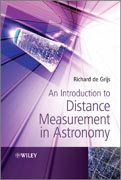
Distance determination is an essential technique in astronomy, and is brieflycovered in most textbooks on astrophysics and cosmology. It is rarely coveredas a coherent topic in its own right. When it is discussed the approach is frequently very dry, splitting the teaching into, for example, stars, galaxies and cosmologies, and as a consequence, books lack depth and are rarely comprehensive. Adopting a unique and engaging approach to the subject An Introduction to distance Measurement in Astronomy will take the reader on a journey from the solar neighbourhood to the edge of the Universe, discussing the range of distance measurements methods on the way. The book will focus on the physical processes discussing properties that underlie each method, rather than just presenting a collection of techniques. As well as providing the most compressive account of distance measurements to date, the book will use the common theme ofdistance measurement to impart basic concepts relevant to a wide variety of areas in astronomy/astrophysics. The book will provide an updated account of the progress made in a large number of subfields in astrophysics, leading to improved distance estimates particularly focusing on the underlying physics. Additionally it will illustrate the pitfalls in these areas and discuss the impact of the remaining uncertainties in the complete understanding of the Universes at large. As a result the book will not only provide a comprehensive study of distance measurement, but also include many recent advances in astrophysics. ÍNDICE: Preface 1 The importance of astrophysical distance measurements 1.1 The distance to the Galactic Centre.. 1.2 The distance to the Large Magellanic Cloud. 1.3 Benchmarks beyond the Magellanic Clouds: the 3D Universe on large(r) scalesBibliography. 2 The solar neighbourhood2.1 Geometric parallax measurements. 2.2 Dynamical parallax.. 2.3 Spectroscopic and photometric parallaxes... Bibliography... 3 From the MilkyWay to the Local Group3.1 Basic stellar physics as the key to understanding distance measurements toLocal Group galaxies... 3.2 Open and globular cluster Hertzsprung-Russell diagrams.. 3.3 Giants and supergiants as standard candles... 3.4 White-dwarf sequences.. 3.5 Period-density relations.. 3.6 Novae as standard candles. 3.7 Geometric methods.. 3.8 Pulsars: distance measurements outside the classical' wavelength range.. Bibliography.. 4 Reaching Virgo cluster distances and beyond4.1 The Hubble Space Telescope Key Project. 4.2 Surface-brightness fluctuations. 4.3 The globular cluster luminosity function.. 4.4 The planetary nebulae luminosity function... 4.5The Tully-Fisher relation. 4.6 Distance indicators specific to elliptical galaxies.. 4.7 The colour-magnitude relation. 4.8 HII regions as distance indicators?. Bibliography. 5 From nearby galaxy clusters to cosmological distances5.1Cosmological redshifts.. 5.2 Supernovae as beacons. 5.3 Indirect techniques to measure H0.. Bibliography... 6 Systematic uncertainties and common pitfalls6.1 Common biases... 6.2 High versus low values of the Hubble constant:science or philosophy?.. Bibliography.. 7 Promises and prospects7.1 The way forward: where are significant gains achievable?... 7.2 The Pleiades distance controversy... 7.3 X-ray scattering haloes.. 7.4 Standard sirens: listening to gravitational waves. 7.5 Three-dimensional mapping of redshifted neutral hydrogen. 7.6 The present-day distance ladder... Bibliography... Glossary Figure credits Index
- ISBN: 978-0-470-51179-4
- Editorial: John Wiley & Sons
- Encuadernacion: Cartoné
- Páginas: 336
- Fecha Publicación: 02/09/2011
- Nº Volúmenes: 1
- Idioma: Inglés
